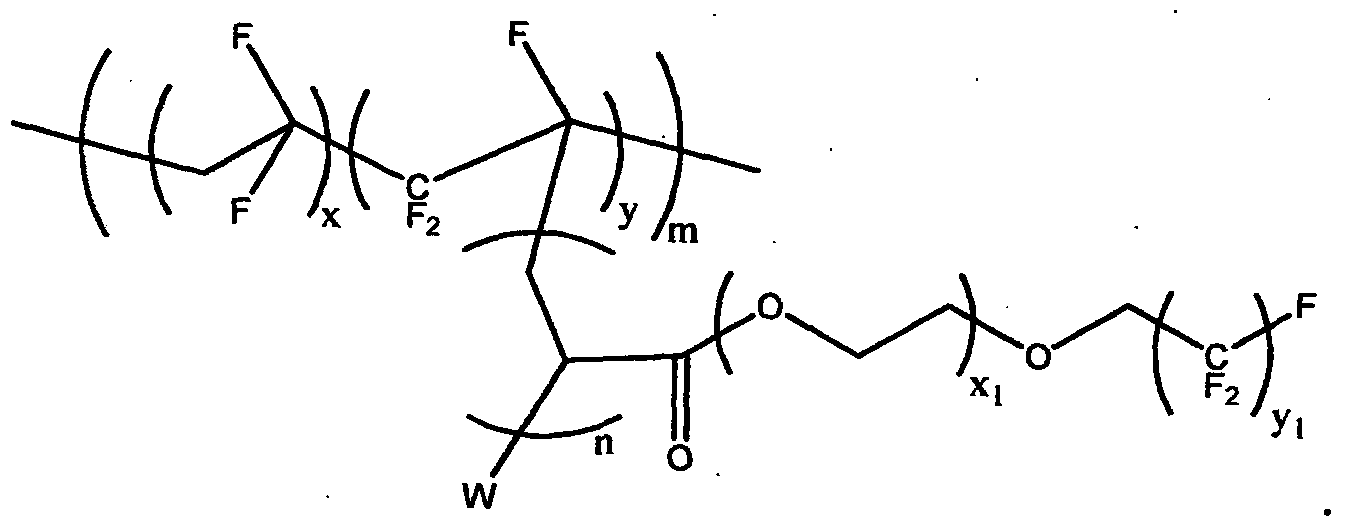A highly hydrophilic and highly oleophobic membrane for oil-water separation
A hydrophilic and oleophobic technology, applied in separation methods, liquid separation, semi-permeable membrane separation, etc., can solve problems such as UF membrane membrane fouling
- Summary
- Abstract
- Description
- Claims
- Application Information
AI Technical Summary
Problems solved by technology
Method used
Image
Examples
Embodiment 1
[0051] Embodiment 1: the preparation of functional polymer
[0052] Poly(vinylidene fluoride-co-chlorotrifluoroethylene) was dissolved in N-methyl-2-pyrpyrrolidone in an airtight flask purged with N2. The mixture was stirred at 200 to 1000 rpm and heated at 60 to 90 °C to obtain a homogeneous viscous polymer solution. The polymer concentration is 10 to 30% by weight.
[0053] CuCl (1 to 5% by weight) and pentamethyldiethylenetriamine (2 to 10% by weight) were added to the above solution, followed by tert-butyl acrylate (10 to 15% by weight).
[0054] The resulting mixture was heated at 50 to 90°C for 0.5 to 4 hours. After cooling, the mixture was poured into water to precipitate the grafted product containing polyacrylate side chains, which was washed with water.
[0055] The grafted product (1 to 10 g) was stirred in toluene p-toluenesulfonate solution (100 mL, 10 to 30% by weight) at 80 to 95° C. for 4 to 8 hours. After cooling, the acidic solution was poured into water,...
Embodiment 2
[0057] Embodiment 2: the preparation of polymer blend solution
[0058] In a sealed container heated to 70 to 100° C., PVDF and the functional polymer prepared in Example 1 were added to dimethylformamide (10 to 30% by weight combination, PVDF:functional polymer=7:3) . The mixture was stirred at 400 to 1000 rpm for 1 to 5 hours and cooled to ambient temperature to obtain a blended solution.
[0059] The blended solution was filtered through a 15 μm stainless steel filter in an airtight stainless steel doping vessel and pressurized by compressed nitrogen at 2 bar pressure.
[0060] The filtered blend solution was degassed by centrifuging the solution at 3000 to 8000 rpm for 5 to 10 minutes.
Embodiment 3
[0061] Embodiment 3: the making of hollow fiber membrane
[0062] Driven by compressed nitrogen, the blended solution of Example 2 was extruded into a water bath using a spinneret with a spinneret of 1.5 / 0.5 OD / ID to form a hollow fiber membrane. Simultaneously, a syringe pump supplies water to the fiber lumen through an annular ring inside the spinneret.
[0063] The air gap is 0.5 cm. The flow rate of the polymer blend solution was maintained at 4 mL / min with compressed nitrogen. Control the flow rate of water to 1 mL / min with a syringe pump. The solidification temperature is 60 to 80°C.
[0064] Finally, the hollow fiber membrane thus obtained was dried in air.
PUM
| Property | Measurement | Unit |
|---|---|---|
| pore size | aaaaa | aaaaa |
| thickness | aaaaa | aaaaa |
| water contact angle | aaaaa | aaaaa |
Abstract
Description
Claims
Application Information
 Login to View More
Login to View More - R&D
- Intellectual Property
- Life Sciences
- Materials
- Tech Scout
- Unparalleled Data Quality
- Higher Quality Content
- 60% Fewer Hallucinations
Browse by: Latest US Patents, China's latest patents, Technical Efficacy Thesaurus, Application Domain, Technology Topic, Popular Technical Reports.
© 2025 PatSnap. All rights reserved.Legal|Privacy policy|Modern Slavery Act Transparency Statement|Sitemap|About US| Contact US: help@patsnap.com



